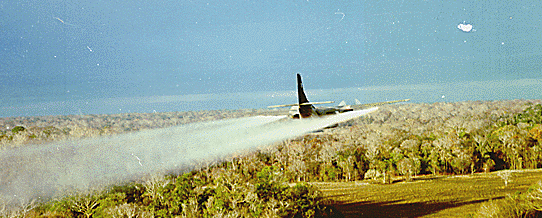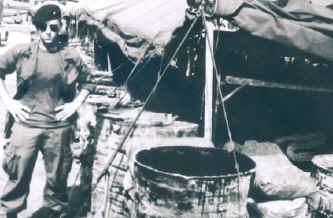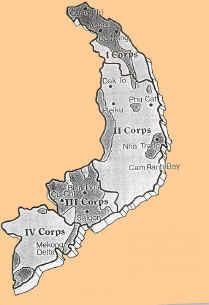|
A G E N T O R A N G E & O T H E R D E F O L I A N T S
The United States Begins Use of Defoliants Jan. 12, 1962 Pink Rose...During the Pink Rose test program target areas near Tay Ninh and An Loc, Vietnam were sprayed with defoliation agents twice and with a drying agent once. Ten flights of three B-52s each dropped 42 M-35 incendiary incendiary cluster bombs, per aircraft, into the target area setting fires that burned the heavy growth as well as enemy fortifications hidden there. Sweeping over the tree-tops this C-123 Ranch Hand aircraft sprays defoliant over the target area., 01/1967 What is Agent Orange? | Agent Orange Photo | The 15 Herbicides Used in Vietnam | List of Presumptive Diseases | News Items | Spina Bifida Information | Agent Orange Links | Fact Sheet on Vietnam Veterans | Map of Vietnam Sprayed Areas | Agent Orange Overview. Approximately 20 million gallons of herbicides were used in Vietnam between 1962 and 1971 to remove unwanted plant life and leaves which otherwise provided cover for enemy forces during the Vietnam Conflict. Shortly following their military service in Vietnam, some veterans reported a variety of health problems and concerns which some of them attributed to exposure to Agent Orange or other herbicides. The Department of Veterans Affairs has developed a comprehensive program to respond to these medical problems and concerns. The principal elements of this program include quality healthcare services, disability compensation for veterans with service-connected illnesses, scientific research and outreach and education. Source: VA VA’s Guide on Agent Orange Claims What is Agent
Orange? Article by: Denise A. and Kelly M. Titled Agent Orange Agent Orange is a code name for a herbicide developed for the U.S. military. It was named for the orange band that was used to mark the drums it was stored in. Made of a 50-50 mix of the chemicals 2, 4, D and 2, 4, 5T and with kerosene or diesel fuel. The primary use was to be in tropical climates, as it was extremely effective against broad-leaf foliage, such as the dense jungle terrain found in Vietnam and throughout Southeast Asia. Source: Article by: Denise A. and Kelly M. Titled Agent Orange...... NOTE: Effective Jan. 31st. 2002 the 30 year limitation on the period during which respiratory cancers must become manifest for service connection (and disability compensation) to be granted on a presumptive basis, has been eliminated. VNHD -------United Veterans of America------
Pictured here in Vietnam is Dr. Barry Krupkin, Supreme National Commander of United Veterans of America (Notice the nice chemical drums). Dr. Barry Krupkin, SNC, Ph.D is an honored member of The Veterans News Hour Daily Advisory Board. His input and guidance is invaluable to the success of this Web Site. Thank you, Barry! U.V.O.A
NATIONAL MEMBERSHIP OFFICE The Fifteen Herbicides Used in Vietnam
GREEN: Contained 2,4,5-T and was used 1962-1964. PINK: Contained 2,4,5-T and was used 1962-1964. ORANGE: A formulation of 2,4,-D and 2,4,5-T used between 1965 and 1970. WHITE: A formulation of Picloram and 2,4,-D. BLUE: Contained cacodylic acid. ORANGE II: A formualtion of 2,4,-D and 2,4,5-T used in 1968 & 1969 (sometimes referred as "Super Orange") DINOXOL: A formulation of 2,4,-D
and 2,4,,5-T. *Small quantities of all of
the above were tested in Vietnam, 1962-1964. Diseases Associated With Exposure to Agent Orange These are the diseases which VA currently presumes resulted from exposure to herbicides like Agent Orange. The law requires that some of these diseases be at least 10% disabling under VA’s rating regulations within a deadline that began to run the day you left Vietnam. If there is a deadline, it is listed in parentheses after the name of the disease.
& CHRONIC LYMPHOCYTIC LEUKEMIA -- See Story Below What if I served in Vietnam and Have a Disease Not on VA'S List? If you served in Vietnam and believe that you have a disease caused by herbicide exposure, but that disease is not on VA'S list of diseases associated with herbicides like Agent Orange, you may still apply for service-connection. Such a veteran needs to establish entitlement to service connection on a "direct" (rather than "presumptive") basis. In these cases, VA requires: 1)
competent medical evidence of a current disability; For more Q/A about Agent Orange
access: ----------NEWS ITEMS---------- Department Of Veterans
Affairs The Department of Veterans Affairs (VA) is adding a new provision to disability compensation and dependency and indemnity compensation (DIC) regulations. The new rule will allow certain disability claims associated with herbicide exposure to be awarded even if the same claims had been previously denied. Benefits awarded will be retroactive to the date of the claim or the date of the previously denied claim. The new rule also provides that VA may pay to certain survivors of a deceased beneficiary, or to the beneficiary's estate, any amounts the beneficiary was entitled to receive under the effective-date provisions of this rule, but which were not paid prior to the beneficiary's death. The purpose of this rule is to reflect the requirements of court orders in a class-action case. Daschle
Legislation Leads to this Expansion of Benefits Senator Daschle
Applauds VA Decision to Compensate WASHINGTON, D.C.
- Senator Tom Daschle today applauded the decision by Secretary of Veterans
Affairs Anthony Principi to extend benefits to Vietnam veterans suffering from
Chronic Lymphocytic Leukemia (CLL). CLL is a cancer of the lymphatic system that
often progresses slowly. The VA made its decision today after
the Institute of Medicine (IOM) released its biennial report to the Secretary
regarding Agent Orange-related diseases and conditions. The IOM literature shows
_sufficient evidence of an association between CLL and exposure to toxic
herbicides in Vietnam._ Legislation sponsored by Senator Daschle in 1991 created
the process that allowed for this update. Throughout my career, I have fought to ensure that Vietnam veterans who were exposed to Agent Orange get the treatment and compensation they deserve, said Senator Daschle. _America owes its veterans a tremendous debt, and I am committed to seeing that the federal government meets its obligations. From 1962 to 1971, U.S. military
forces sprayed herbicides over Vietnam to strip the thick jungle canopy that
helped conceal opposition forces, to destroy crops that enemy forces might
depend on, and to clear tall grasses and bushes from the perimeters of U.S. base
camps and outlying fire-support bases. The herbicide mixtures used were named
according to the color of an identification band painted on the storage drums;
one of the main chemical mixtures sprayed was Agent Orange. Daschle, a Vietnam-era Air
Force veteran, has been a long-time advocate for veterans and families dealing
with the health effects of Agent Orange exposure. In his first year in
Congress, 1979, Daschle helped win passage of the Veterans Health Programs
Extension and Improvement Act, which required the VA to conduct an
epidemiological study of the long-term health effects of veterans_ exposures Over the next 11 years, he and others
won passage of legislation providing a health care entitlement to veterans
exposed to Agent Orange and to expand the scope of the Agent Orange study.
Daschle’s landmark accomplishment came when Congress finally passed the Agent
Orange Act of 1991, the first comprehensive law to address the problems of
veterans exposed to Agent Orange. The act allows veterans to receive
disability compensation for diseases shown to be associated with their exposure to Agent Orange
and other herbicides and also requires a biennial review of new dioxin and other
relevant research, with mechanisms for updating VA disability compensation
eligibility guidelines. Daschle said today’s decision means that Vietnam veterans with CLL will qualify for disability compensation of approximately $2,300 per month and will not have to pay copayments for treatments for CLL. They will also have improved access to VA health services. Related Story: VA To Grant Benefits To More Vietnam Veterans - WASHINGTON – Based upon a recently released review of scientific studies, Secretary of Veterans Affairs Anthony J. Principi has decided to extend benefits to Vietnam veterans with chronic lymphocytic leukemia (CLL). (1/23/03) Spina Bifida Healthcare The Following
Re-published From: The VA Spina
Bifida Web Site. Dept. of Veterans
Affairs Overview In addition to monetary allowances, vocational training and rehabilitation, the Department of Veterans Affairs (VA) also provides VA-financed healthcare benefits to Vietnam veterans' birth children diagnosed with spina bifida. For the purpose of this program, spina bifida is defined as all forms or manifestations of spina bifida (except spina bifida occulta), including complications or associated medical conditions related to spina bifida. Healthcare benefits available under this program are limited to those necessary for the treatment of spina bifida and related medical conditions. Beneficiaries should be aware that this program is not a comprehensive healthcare plan and does not cover medical services unrelated to spina bifida. While administration of the program is centralized to VA's Health Administration Center (HAC) in Denver, Colorado, applications must first be made through the Denver VA regional office. Contact the Denver regional office by calling 1-888-820-11756. Once the Denver VA regional office determines eligibility, spina bifida awardees (or guardians) are automatically contacted by the Health Administration Center and registered for healthcare benefits. Beneficiaries receive detailed program material from HAC specifically addressing covered and noncovered services and supplies, preauthorization requirements, and claim filing instructions. Once registered, the HAC assumes responsibility for all aspects of the spina bifida healthcare program, including the authorization of benefits and the subsequent processing and payment of claims. Spina
Bifida Healthcare Program (01-6) Benefits In general, the program covers most healthcare services and supplies that are medically or psychologically necessary for the treatment of conditions related to spina bifida. While some services require specific advance approval or preauthorization, the following services are specifically excluded from coverage
Assistance Eligibility/Application Information 1-800-820-1756
(News & Information Links) Vietnam Veterans now have a new national toll-free helpline to answer their questions about Agent Orange exposure, health care and benefits..... (Mar. 9, 2001) Click Here VA has developed a specific Agent Orange Web Page in conjunction with the helpline. It can be accessed at www.vba.va.gov/bln/21/benefits/herbicide. VA To Create Benefits for Some Childhood Leukemia Victims -- April 20, 2001 -- Washington -- Hours after receiving a study that linked Agent Orange to a deadly form of childhood leukemia, Secretary of Veterans Affairs Anthony J. Principi ordered the Department of Veterans Affairs (VA) to begin setting up benefits for these children. Click here to read full press release Vietnamese and U.S. officials have agreed for the first time to study the possible effects of Agent Orange. Click on CNN World to read this article. V.A. News Release: Nov. 9th, 2000 Washington D.C. Vietnam Veterans with Type II Diabetes will now be eligible for disability compensation from the department of Veteran Affairs based on their presumed exposure to Agent Orange or other herbicides. Acting Secretary Hershel W. Goober announced today his decision to add Diabetes to the list of presumptive diseases associated with herbicide exposure. Full Story Access: V.A.Website Benefits Approved for
Children of This legislation will provide monthly disability allowances, vocational training, and health care to women Vietnam veterans' children born with certain medical conditions. "These women veterans made huge sacrifices to protect our freedom, and it is only just that their children with resulting medical conditions be compensated," commented President Clinton the day of the bill signing. "Similar benefits are currently afforded to such children who were born with spina bifida, but this Act will expand benefits beyond that one condition." Korea Agent Orange Exams If you Served in Korea's DMZ in 1968-1969 you may receive a free VA medical exam to test for exposure to Agent Orange sprayed by the South Korean Army. This will not entitle you to any compensation for illness related to chemical defoliant exposure however. You may be listed on the Agent Orange Registry and have your health conditioned tracked in research database. A VA newsletter will be sent out to you with any further updates. This Sept. 5th Directive from the VA can be Accessed by going to the VA Website. Correction : From Department of Veterans Affairs; On page 14 of Agent Orange Review: The article on Korean Veterans may have erroneously indicated that veterans exposed to herbicides outside Vietnam are not entitled to any presumptions. Of course as was stated on pages 11-12, this is not the case. If it is determined that a veteran was exposed outside Vietnam during his or her military service to a chemical contained in one of the herbicides used in Vietnam, and he or she has a disease on VA'S presumptive list, it will be presumed to be service connected. We apologize for any confusion. VA FROM AGENT
ORANGE 2000 For
VA benefits, two dates are used for the “Vietnam era:” 1 t
Feb. 28, 1961 to May 7,
1975, for veterans who served in Vietnam t
Aug. 5, 1964 to May 7,
1975, for all other veterans Vietnam Veterans l
9.2 million served on
active duty (Aug. 5, 1964 to May 7, 1975) 2 l
2,590,000 served in the
combat zone 7 l
109,000 died in service
2 l
58,184 died in the
combat zone or from combat wounds 4 l
8,113,000 are still
alive 2 Vietnam
Vets and VA Health Care 3 l
125,275 vets were hospitalized 206,763 times in VA facilities last year l
989,833 vets visited VA clinics 12,704,963 times last year l
991, 672 vets received some VA health care last year Vietnam
Vets and VA benefits 5 l
737,397 vets received disability compensation in February l
112,207 family members of dead vets receive survivors benefits l
102,088 vets received VA pensions for non-service disabilities Vietnam
Veterans and Agent Orange 6
l
297,194 vets took exams under Agent Orange Registry since March 2000
l
99,226 filed claims alleging Agent Orange affected their health
l
7,520 receive VA disability compensation for Agent Orange-related causes Notes 1.
38 U.S. Code, 101 (29). 2.
“America’s Wars,” Department of Veterans Affairs, August 1999. 3.
“Inpatients and
Outpatients by Period of Service, FY 1999,” April 2000, Office of Program and
Data Analyses VA. 4.
“U.S. Military
Casualties in Southeast Asia,” March 31, 1997, Department of Defense,
Washington Headquarters Service, Directorate for Information Operations and
Reports. (http://web1.whs.osd.mil/mmid/casualty). 5.
“Active Compensation, Pension and Retirement Cases By Period of
Service,” February 2000, Office of Program and Data Analyses, VA. 6.
“Agent Orange: Statistical Update,” March 2000, VA Office of Public
Affairs, Media Relations Office (80-F). 7.
Pentagram,
June 4, 1993 Agent Orange Review: Agent Orange Benefits: AS OF THE AGENT ORANGE
REVIEW AUG. 2000 IF YOU WISH TO RECEIVE A THOROUGH PUBLICATION ON THE MANY FACETS OF THIS VERY COMPLICATED ISSUE, PLEASE WRITE TO AGENT ORANGE REVIEW, ENVIRONMENTAL AGENTS SERVICE (131), VA CENTRAL OFFICE, 810 VERMONT AVENUE, NW, WASHINGTON D.C. 20420. THEY ASK YOU INCLUDE YOUR NAME ADDRESS AND SOCIAL SECURITY NUMBER. FOR IMMEDIATE RELEASE March 9, 2001 Toll-Free Agent Orange Helpline Established for Vietnam Veterans WASHINGTON -- Vietnam veterans now have a new national toll-free helpline to answer their questions about Agent Orange exposure, health care and benefits. The new helpline -- 1-800-749-8387 --is part of the continuing efforts of the Department of Veterans Affairs (VA) to reach America's 2.3 million Vietnam veterans. Callers can speak directly to VA representatives Monday through Friday from 8 a.m. to 4 p.m., Central Standard Time, or access a 24-hour automated system. They can leave voice mail messages to have information sent to them or listen to recordings about exposure to Agent Orange, VA benefits, health care and disability compensation. "As scientific studies expand our understanding of the possible long-term health effects of Agent Orange spraying in Vietnam, VA is increasing its programs for affected veterans," said Secretary of Veterans Affairs Anthony J. Principi, himself a Vietnam veteran. "VA is committed to reaching out to these veterans and their families whenever and wherever possible to ensure they receive the health care and other benefits they deserve." VA expects considerable interest in the helpline because of a proposed policy that allows Vietnam veterans with adult-onset (Type II) diabetes to receive disability compensation for ongoing medical problems linked to Agent Orange or other herbicides during the war. VA now recognizes 10 medical conditions as being associated with Agent Orange. Agent Orange was a herbicide used to unmask enemy hiding places and destroy foliage during the war. It has been linked to a variety of health problems, ranging from rare conditions and certain birth defects in veterans' offspring to diseases that are somewhat common in middle age, such as prostate cancer and adult-onset diabetes. A regulation to provide monthly compensation for Vietnam veterans with adult-onset diabetes is expected later this year. VA estimates that approximately 200,000 Vietnam veterans will receive service-connection for their diabetes within the first five years under the new policy. About 36,000 veterans from all periods of service are already recognized as "service connected" for diabetes. As part of its outreach, VA is expanding its Agent Orange Review newsletter mailings to over 600,000 identified, in-country Vietnam veterans. A special issue of the newsletter has been prepared which summarizes VA benefits for veterans exposed to Agent Orange and the procedures to obtain benefits. The newsletter, along with the helpline, builds upon longstanding VA outreach to let Vietnam veterans know of changes to their benefits. Over the last 18 years, VA has provided periodic newsletters to over 300,000 Vietnam veterans who have received free Agent Orange-related physical examinations. The helpline is located at the St. Louis VA Regional Office, which has a similar toll-free helpline for Gulf War veterans. The two helplines will share the same telephone number, with callers selecting the service they wish. For general information on VA benefits and programs, visit VA's website at www.va.gov. VA has developed a specific Agent Orange Web Page in conjunction with the helpline. It can be accessed at www.vba.va.gov/bln/21/benefits/herbicide. VA To Create Benefits for Some Childhood Leukemia VictimsApril 20, 2001 WASHINGTON -- Hours after receiving a study that linked Agent Orange to a deadly form of childhood leukemia, Secretary of Veterans Affairs Anthony J. Principi ordered the Department of Veterans Affairs (VA) to begin setting up benefits for these children. "The medical evidence is clear and persuasive that these illnesses are associated with the service of our men and women during the Vietnam War," said Principi. "Equally clear is VA's responsibility to provide benefits and programs that meet the needs of these veterans and their families." Principi's decision affects the children of Vietnam veterans with acute myelogenous leukemia, a rare, deadly form of the childhood disease. The Institute of Medicine (IOM) released a report April 19 that cited "limited or suggestive" evidence that a parent's exposure to Agent Orange during the Vietnam War may lead to a child contracting the disease. About 500 to 1,000 children of Vietnam veterans are believed to have the disease. Since VA has no legal authority to provide benefits for these children, Principi said he has obtained White House approval to ask Congress for legislation to create special benefits. VA officials are determining what those benefits should be. In 1997, VA set up a program for the children of Vietnam veterans with spina bifida. That program provides health-care benefits, vocational training and a monthly allowance based upon the severity of the illness. About 940 people with spina bifida are now receiving these VA benefits. MAP OF VIETNAM -- SPRAYED AREAS
|





